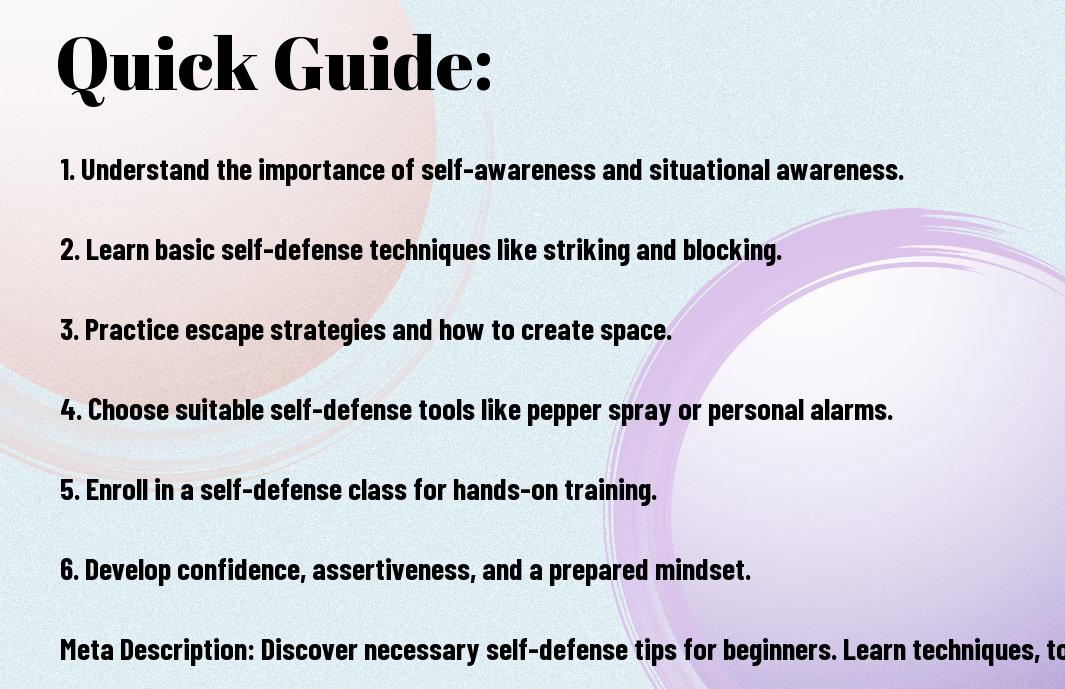Over empowering and protecting yourself is paramount in any situation. Whether you’re walking alone at night or simply want to feel more confident in your daily life, learning the basics of self-defense is a crucial skill. In this comprehensive guide, we’ll cover everything beginners need to know to stay safe and secure.
From basic self-defense techniques to understanding situational awareness, this guide will equip you with the knowledge and skills necessary to defend yourself effectively. We’ll research into the importance of physical and mental preparedness, as well as how to identify and avoid potential threats before they escalate. Stay tuned to empower yourself with the crucial tools for self-defense.
With real-world scenarios and practical tips, this guide is designed to educate and empower individuals who are new to the world of self-defense. Whether you’re a beginner or looking to refresh your knowledge, self-defense is a universal skill that can save lives. Let’s explore the fundamental principles and techniques together.
Covering everything from basic techniques to situational awareness, this guide is crucial for beginners looking to empower and protect themselves through self-defense.
Key Takeaways:
- Self-defense Awareness: Being alert and aware of your surroundings is the first step towards self-protection.
- Basic Self-defense Techniques: Learn simple moves like palm strikes, knee strikes, and eye gouges for effective defense.
- Practice Regularly: Consistent practice is key to mastering self-defense skills and being prepared for any situation.
- Use Your Voice: Verbally assert yourself to deter attackers and draw attention to your situation.
- Seek Professional Training: Consider taking self-defense classes to improve your techniques under expert guidance.
Understanding Self-Defense
Definition and Principles
There’s more to self-defense than physical techniques; it encompasses a mindset and a set of principles that form the foundation of effective protection. Regarding self-defense, understanding is key. Self-defense is the practice of defending oneself from physical harm through the use of strategies and techniques to prevent injury or harm to oneself. It’s about being aware of your surroundings, recognizing potential threats, and de-escalating situations before they become dangerous.
Self-defense principles emphasize avoidance, de-escalation, and the use of proportional force only when necessary. It’s crucial to prioritize your safety and well-being above all else, knowing when and how to defend yourself effectively. By understanding the principles of self-defense, you can better prepare yourself to handle threatening situations confidently and decisively.
Mastering self-defense is not just about physical strength; it’s about mental preparedness, awareness, and confidence. By familiarizing yourself with the principles of self-defense, you can navigate potential dangers with a clear mind and the ability to protect yourself effectively.
Legal and Ethical Considerations
You must be aware of the legal and ethical aspects of self-defense to protect yourself both physically and legally. SelfDefense is a legal right, but the use of force must be justified and proportional to the threat you face. It’s crucial to understand the laws in your jurisdiction regarding self-defense and what constitutes justifiable force.
When considering self-defense, always prioritize de-escalation and escape whenever possible. While defending yourself is important, engaging in unnecessary physical confrontations can lead to legal consequences. It’s vital to know when to defend yourself, how to do so responsibly, and when to seek help from authorities.
Understanding the legal and ethical considerations of self-defense is paramount in staying safe and avoiding unnecessary trouble. By knowing your rights and responsibilities, you can protect yourself effectively without crossing legal or ethical boundaries.
Types of Self-Defense
Many individuals are interested in learning self-defense techniques to protect themselves from harm. There are various forms of self-defense that cater to different situations and levels of physical ability. Knowing the right techniques can make a significant difference in dangerous encounters.
| 2. Armed Self-Defense |
3. Non-physical Self-Defense |
Unarmed Self-Defense
To effectively defend oneself without the use of weapons, individuals can learn techniques such as kickboxing, jiu-jitsu, and krav maga. These disciplines focus on leveraging the body’s natural strength and agility to overcome attackers. Training in unarmed self-defense provides valuable skills for various real-life scenarios, empowering individuals to protect themselves.
Developing proficiency in unarmed self-defense requires dedication and consistent practice. Techniques such as blocks, strikes, and joint locks are crucial components of unarmed self-defense training. By mastering these skills, individuals can effectively neutralize threats and escape dangerous situations unharmed.
Understanding the principles of balance, leverage, and timing is crucial in unarmed self-defense. By honing these skills, individuals can efficiently defend themselves against larger or stronger opponents. Proper training in unarmed self-defense instills confidence and preparedness in individuals, equipping them to react swiftly in perilous circumstances.
Armed Self-Defense
Assuming a defensive stance with the use of weapons like firearms, stun guns, knives, or pepper spray can be a critical component of self-defense in certain situations. Training in armed self-defense involves understanding weapon safety, proper handling, and legal implications. Armed self-defense emphasizes the importance of de-escalation and using force as a last resort.
For instance, carrying a concealed firearm for self-defense requires extensive training and a deep understanding of firearm laws. Individuals opting for armed self-defense must prioritize safety, responsibility, and ethical use of weapons. Proper training ensures that individuals can effectively protect themselves while minimizing risks to themselves and others.
Non-physical self-defense techniques encompass strategies such as verbal de-escalation, situational awareness, and assertiveness. Even without physical confrontation, individuals can deter potential threats by utilizing communication skills and conflict resolution strategies. Non-physical self-defense empowers individuals to navigate risky situations with composure and confidence.
Objects that can serve as improvised self-defense tools include everyday items like keys, flashlights, or umbrellas. Even when unarmed or without traditional weapons, individuals can use these objects strategically to defend themselves. Incorporating non-physical self-defense techniques into one’s skill set enhances personal safety and preparedness in a variety of scenarios.
Preparing for Self-Defense
Mental Preparation
For an effective self-defense strategy, mental preparation is crucial. Understanding potential threats and staying alert are important for your safety. Be aware of your surroundings at all times and trust your instincts. Developing a mindset that prioritizes safety and quick decision-making can make a significant difference in dangerous situations.
Practice visualization techniques to envision possible scenarios and plan your responses. Engaging in self-defense classes can boost your confidence and mental resilience. Recall, self-defense is not just physical; it starts with mental readiness and awareness.
Stay calm under pressure and be prepared to defend yourself if necessary. Self-defense is about empowerment and safeguarding your well-being. By honing your mental readiness, you equip yourself with the tools to protect yourself effectively.
Physical Conditioning
The physical aspect of self-defense is equally important. Regular exercise and strength training can enhance your ability to react swiftly and effectively in dangerous situations. Building core strength and agility can help you evade attacks and defend yourself better.
Learning basic self-defense moves and practicing them regularly can improve muscle memory and coordination. Incorporate cardio workouts to boost endurance and stamina, vital for self-defense scenarios. Physical conditioning not only strengthens your body but also sharpens your reflexes and response times.
It is important to maintain your physical fitness and agility to increase your chances of escaping or overcoming a potential threat. Recall, the goal is not to engage in conflict but to protect yourself and remove yourself from harm’s way.
It’s important to be mentally and physically prepared for any self-defense situation. Developing a vigilant mindset and honing physical strength can significantly improve your ability to react to threats effectively and protect yourself. By prioritizing mental readiness and physical conditioning, you empower yourself with the tools needed to stay safe in various scenarios.
Empower yourself with self-defense knowledge! Learn important mental and physical preparation techniques to stay safe and confident in any situation. Master the art of self-protection today.
Factors Influencing Self-Defense
Unlike other martial arts, self-defense is more about practical techniques than flashy moves. Being aware of the factors that can impact your ability to defend yourself is crucial for effective training and preparedness. Let’s probe into some key elements that play a significant role in self-defense situations.
Size and Strength Disparities
For self-defense, size and strength imbalances between individuals can greatly affect the outcome of a confrontation. It’s vital to understand that technique and strategy can often overcome raw power. Developing skills in leverage, joint manipulation, and using an assailant’s momentum against them can level the playing field in a self-defense scenario.
Adapting your defensive tactics to suit your physical capabilities and learning how to exploit an opponent’s weaknesses are fundamental in overcoming size and strength differentials. Recall, self-defense is about protecting yourself and others from harm, not engaging in a physical power struggle.
Thou should focus on honing your reflexes, agility, and mental acuity alongside physical training to effectively defend yourself in various situations where size and strength imbalances may come into play.
Environmental Factors
For self-defense, environmental factors such as lighting conditions, terrain, and the presence of obstacles can significantly impact your ability to react and respond to threats. Being aware of your surroundings and potential hazards is crucial for effective self-defense preparation.
- Environmental factors can include crowded areas, confined spaces, or unfamiliar locations that may limit your mobility and escape routes during a confrontation.
Perceiving and assessing potential risks in your environment allows you to make informed decisions and adapt your self-defense strategies accordingly. Recall, awareness is your first line of defense in any situation.
Strength
Psychological Factors
If you find yourself in a self-defense situation, your mental state and emotional resilience play a critical role in determining the outcome. Remaining calm under pressure, managing fear and anxiety, and making quick decisions are vital psychological factors in self-defense.
The ability to psychological factors like fear, stress, and adrenaline can impact your judgment and physical performance during a confrontation. Training in scenarios that simulate high-stress situations can help you develop the mental fortitude needed to react effectively in real-life self-defense scenarios.
The Psychological factors of confidence, assertiveness, and situational awareness can empower you to de-escalate conflicts, set boundaries, and make split-second decisions to ensure your safety and the safety of those around you.
If you want to master the art of self-defense, understanding the psychological aspects of combat is as crucial as mastering physical techniques. The ability to remain composed, focused, and adaptive in high-pressure situations can be the defining factor in your ability to protect yourself effectively.
- Developing mental resilience and emotional control is key to overcoming psychological factors that may impede your ability to respond effectively in self-defense situations.
With self-defense techniques tailored to address size and strength imbalances, environmental factors, and psychological aspects of combat, you can enhance your preparedness and confidence in safeguarding yourself against potential threats.
Basic Self-Defense Techniques
Stance and positioning
Not only is knowledge about self-defense crucial, but the right stance and positioning can significantly affect your ability to defend yourself effectively. To start, always keep your feet shoulder-width apart, knees slightly bent, and balance on the balls of your feet. Your non-dominant hand should be out in front as a barrier, while your dominant hand is closer to your face, ready to strike or defend.
Another important aspect of stance and positioning is always facing your attacker directly and keeping your body at an angle to make yourself a smaller target. Remember to stay calm and focused, as panicking can lead to poor decision-making and hinder your ability to defend yourself.
By mastering the proper stance and positioning techniques, you can create a strong foundation for executing both defensive and offensive moves effectively in self-defense situations.
Defensive moves
Stance is vital for executing defensive moves correctly. When an attacker approaches, remember to keep your stance firm and balanced. Practice blocking techniques such as using your forearms to shield against strikes or kicks.
Defensive moves are imperative for creating space between you and your attacker and buying time to assess the situation and plan your next move. Make sure to practice these moves regularly to ensure they become instinctual and can be executed swiftly in a crisis.
Having a repertoire of defensive moves at your disposal increases your chances of protecting yourself and escaping from dangerous situations unharmed.
Offensive moves
Moves such as striking vulnerable areas like the eyes, throat, or groin can incapacitate your attacker and give you an opportunity to escape. Remember to strike quickly and decisively, using the element of surprise to your advantage.
Offensive moves should only be used as a last resort when escape is not possible. Offensive moves can also include joint locks and pressure points, which can help restrain your attacker until help arrives.
While offensive moves can be effective, it’s crucial to use them judiciously and remember that the goal of self-defense is to protect yourself and escape from harm.
Step-by-Step Self-Defense Scenarios
Responding to grabs and holds
| SelfDefense | Response |
| 1. Stay calm and assess the situation. | Ensure your safety by creating distance or neutralizing the threat. |
| 2. Use leverage and pressure points to break free. | Apply pressure to sensitive areas to gain the upper hand. |
| 3. Practice techniques regularly to build muscle memory. | Enroll in a self-defense class to improve your skills and confidence. |
Defending against strikes and kicks
Step by Step Understanding how to defend against strikes and kicks is crucial in self-defense. Learn to anticipate movements, block effectively, and react swiftly to protect yourself.
Handling ground attacks
| Responding | Tactics |
| 1. Stay composed and focused. | Use your surroundings to your advantage and aim for vulnerable areas. |
| 2. Practice ground defense techniques regularly. | Learn how to escape common holds and control your opponent. |
| 3. Develop situational awareness to prevent ground attacks. | Avoid risky situations and trust your instincts in unfamiliar environments. |
Countering weapons threats
An important aspect of self-defense is knowing how to counter weapons threats. Whether faced with a knife, gun, or blunt object, learning effective techniques can save your life.
Countering a weapons threat requires quick thinking and precision. Practice disarming techniques with caution and always prioritize your safety above all else. Bear in mind, prevention is key in avoiding dangerous situations.
Self-Defense Tips for Specific Situations
After learning the basics of self-defense, it’s crucial to understand how to apply these techniques in different situations. Below are some valuable tips for specific scenarios.
Self-defense at home
One of the fundamental aspects of self-defense at home is awareness. Always be mindful of your surroundings and have a plan in place in case of an emergency. Securing your home with sturdy locks, alarms, and well-lit entryways can deter potential intruders. Additionally, practicing home defense drills with your family can ensure everyone knows what to do in a crisis.
If you find yourself facing an intruder, remember that your priority is to protect yourself and your loved ones. Use any available tools or weapons to defend yourself, and if possible, retreat to a safe location while contacting authorities for help. Any noises or signs of a break-in should prompt a call to 911 immediately.
Self-defense on the street
With respect to self-defense on the street, being aware of your surroundings is key. Avoid isolated areas, stick to well-lit paths, and trust your instincts if something feels off. Remember that confidence can deter potential attackers, so walk with purpose and make eye contact with others.
home Understanding common self-defense techniques such as striking vulnerable areas like the eyes, throat, and groin can be crucial in street confrontations. Additionally, verbal de-escalation skills can help diffuse tense situations before they escalate. Any signs of danger should prompt you to seek help from passersby or nearby businesses.
Self-defense in social situations
Tips for self-defense in social situations include setting boundaries with others and trusting your intuition if a situation feels uncomfortable. Avoid excessive alcohol consumption, as it can impair your judgment and reaction time. Remember that your personal safety should always be a top priority in any social setting.
situations To enhance your safety in social gatherings, consider taking a self-defense class specifically tailored to handling social scenarios. Practicing assertiveness and learning how to escape from unwanted advances can empower you in various social interactions. Any signs of aggressive behavior from others should prompt you to remove yourself from the situation and seek help if needed.
Self-defense while traveling
If you’re traveling, it’s crucial to remain vigilant and aware of your surroundings at all times. If visiting a new destination, research local safety tips and potential risks beforehand. Carry a whistle or personal alarm with you for added security, and avoid displaying expensive belongings in public.
Avoiding dark or isolated areas can minimize the risk of becoming a target for crime while traveling. If you feel uncomfortable or threatened, trust your instincts and seek help from local authorities or reputable establishments. A mindful approach and proactive mindset are key to staying safe while exploring new environments.
The most important aspect of self-defense while traveling is preparation. Pack necessarys like a flashlight, first aid kit, and emergency contacts in case of unforeseen situations. Additionally, learning basic phrases in the local language for seeking help can be invaluable in emergencies. Remember to always prioritize your well-being and take proactive steps to ensure a safe and enjoyable travel experience.
Self-defense for beginners: everything you need to know Meta Description: Discover necessary self-defense tips for various situations, from defending your home to staying safe while traveling. Empower yourself with practical strategies to enhance your personal safety.
Pros and Cons of Different Self-Defense Approaches
Comparing martial arts styles
Martial arts style
| Pros | Cons |
| Effective for self-defense | Requires time to master |
| Improves physical fitness | Physical contact can lead to injuries |
| Offers discipline and focus | Not always practical in real-life situations |
On use of makeshift weapons
Use of makeshift weapons
On the streets, everyday objects can turn into powerful defensive tools in a moment of need.
Pros and cons of carrying defensive tools (e.g., pepper spray, stun gun)
Approaches
| Pros | Cons |
| Provides a non-lethal defense option | Can be taken and used against you |
| Offers distance between you and the attacker | Misuse of the tool can have legal consequences |
Impact of self-defense on personal mindset and safety
Impact of self-defense on personal mindset and safety
Self-defense training can boost confidence and awareness, potentially deterring attackers.
Comparing Impact: Emphasizing the right self-defense approach for you can make all the difference in staying safe.
Continuing Your Self-Defense Education
Despite completing your initial self-defense training, it’s necessary to continue learning and refining your skills to stay prepared for any situation that may arise.
Training resources and options
If you’re looking to expand your self-defense knowledge, there are various resources and options available. Consider enrolling in advanced self-defense classes, workshops, or seminars to further hone your techniques. Additionally, online tutorials, books, and instructional videos can provide valuable insights and tips to enhance your self-defense capabilities.
Joining a local self-defense group or club is another excellent way to continue your education. These communities offer opportunities to practice with peers, receive feedback from experienced instructors, and participate in realistic scenarios to test your skills in a safe environment.
Self-defense training should be an ongoing journey that empowers you to protect yourself and others effectively. By exploring different resources and options, you can continue to evolve and improve your self-defense skills over time.
Building a personal self-defense plan
If you want to take your self-defense readiness to the next level, creating a personal self-defense plan is crucial. This plan should include assessing potential risks in your environment, developing strategies to avoid dangerous situations, and knowing how to react if confronted with a threat.
Plus, consider learning about de-escalation techniques, awareness drills, and legal aspects of self-defense to ensure you’re well-rounded in your approach. By proactively planning and preparing for various scenarios, you can boost your confidence and readiness to handle challenging situations effectively.
Keeping skills sharp with regular practice
- Education
- Personal
Keeping your self-defense skills sharp requires regular practice and dedication. Set aside time each week to rehearse different techniques, scenarios, and drills to maintain muscle memory and improve your response time in high-stress situations.
Whether through solo practice at home, attending training sessions, or participating in simulated confrontations, consistent practice is key to staying proficient in self-defense. Additionally, seeking feedback from instructors or peers can help identify areas for improvement and fine-tune your skills for maximum effectiveness.
By prioritizing regular practice and continuous learning, you can enhance your self-defense abilities and ensure you’re always prepared to protect yourself and others in any circumstance.
To wrap up
Summing up, self-defense is a skill that everyone should consider learning. By understanding basic self-defense techniques, situational awareness, and the laws surrounding self-defense, beginners can feel more confident and prepared in potential threatening situations. Note, practice and consistency are key to mastering self-defense techniques, so make a commitment to your own safety and well-being.
Whether you choose to enroll in a self-defense class or practice at home, the knowledge and skills gained can make a significant difference in your ability to protect yourself. Stay informed, stay alert, and always prioritize your safety. With these beginner tips and guidance, you can take the first steps towards empowering yourself through self-defense.
Self-defense is not just about physical techniques; it’s also about mental and emotional preparedness. By arming yourself with knowledge and skills, you are taking an active role in your personal safety. Keep practicing, stay vigilant, and empower yourself through self-defense today.
Dive into the world of self-defense with our comprehensive guide for beginners. Learn necessary techniques and tips to protect yourself effectively.
FAQ
Q: What is self-defense?
A: Self-defense is a set of skills and techniques that enable individuals to protect themselves from harm or danger.
Q: Why is self-defense important?
A: Self-defense is crucial for personal safety and empowerment, helping individuals respond effectively in dangerous situations.
Q: What are some basic self-defense moves for beginners?
A: Basic self-defense moves for beginners include striking techniques, blocks, and simple escape maneuvers.
Q: How can beginners improve their self-defense skills?
A: Beginners can improve their self-defense skills by practicing regularly, taking classes or workshops, and staying aware of their surroundings.
Q: Is it necessary to learn self-defense as a beginner?
A: Yes, learning self-defense as a beginner is necessary for building confidence, developing awareness, and ensuring personal safety in various situations.





1 thought on “Self-defense for beginners: everything you need to know.”
Comments are closed.